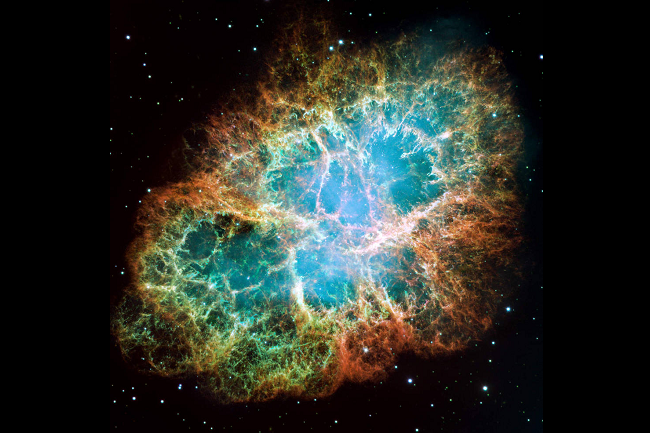Jakarta, Gatra.com- On July 4, 1054, a new point of yellow light was seen in the constellation Taurus, precisely in the southern horn of the Bull. This “guest star” is said to be as bright as the moon, and fails to disappear at sunrise — for a month, it shines day and night. Even after fading in the daytime, it remained shining in the night sky for almost two years.
Taurus is the 17th largest constellation in the sky, occupying an area of 797 square degrees. It is one of the 15 equatorial constellations. It is located in the first quadrant of the Northern Hemisphere (NQ1) and can be seen at latitudes between 90° North Latitude and 65° South Latitude. Central Java is located at coordinates 5° 40′ and 8° 30′ south latitude, included in the line of sight of the Taurus constellation.
Some sources say this astronomical event occurred above the earth’s sky in Mataram, Central Java. The incident was considered a bad omen that triggered the transfer of the Hindu Mataram kingdom in Mataram to Medang, Jombang, East Java. However, the general theory about the displacement of the kingdom was triggered by the eruption of Mount Merapi.
Looking at historical facts, the transfer of work from Central Java to East Java took place a century before the spectacular event. Mpu Sindok, the first king of the Medang Kingdom of the East Java period, ruled around 929-947, with the title of Sri Maharaja Rakai Hino Sri Isana Wikramadharmottunggadewa.
So when there was a star explosion over Mataram, there were no big kingdoms in Central Java. At that time they became a vassal area. The Nagarakertagama manuscript records those areas as Watukura, Mêdang, Waleri, Sêcang, Têlang, Lasêm, Mataram, and Pajang.
Despite this historical error, historians and scientists think that the stellar exploding event over Mataram was likely a supernova that created the Crab Nebula, one of the most spectacular and rare astronomical features in the universe.
The Crab Nebula is a complex shell of expanding gas with a dense and highly magnetic neutron star, or pulsar, at its center. Pulsars — the crumbling remains of stars that disintegrate in explosions, or novae — are so named because they appear to emit radio waves at regular intervals. However, these radio pulses are actually generated from the rotating motion of the star.
Like a rotating mirror in a lighthouse, the signal reaches Earth as the Crab Nebula’s pulsar rays sweep across our space (at a speed of 30 times per second). The massive energy generated by this rotating power plant fueled the expansion of the Crab Nebula and gave its gas cloud a luminosity 75,000 times that of the sun.
The explosion of the star is recorded in the most scientifically useful historical references still in the treatises of the East. According to “Sung Shih,” the annual record of China’s Sung Dynasty, the guest star remained visible for nearly 653 days. In “Sung-Hui Yao,” another historical document, the star appears on July 4 and remains visible in daylight for 23 days.
The Japanese texts record the same story, although they slightly disagree on the date. The histories “May Getsuki” and “Ichidai-yoki” record the appearance of a guest star “in the orbit of Orion” between six and 16 days before July 4, 1054.
George W. Collins II, an astronomer at Case Western University in Cleveland, Ohio, and colleagues William P. Claspy and John C. Martin, analyzed various references to the history of supernovae in a 1999 paper. Ancient Chinese and Japanese astronomers had relatively good understanding advanced about the cosmos, they wrote — closer to modern scientific thought than any other civilization at the time.
Although these astronomers still view celestial events in the context of omens and superstitions, they use fairly accurate positional measurements and understand the relationship between events at night and in the morning. While Eastern astronomers may have kept the most scientifically useful record of supernovae, they were almost certainly not alone in noticing the dramatic event.
Native Americans appear to have recorded the event in petrographs (rock paintings) and petroglyphs (rock carvings). In 1955, astrophotographer William Miller first connected supernovae with Anasazi rock art found in Navajo Canyon and White Mesa in Arizona. Since then, archaeologists have linked other Native American work, including paintings from Chaco Canyon in New Mexico, to the Crab Nebula supernova. Although it was later discovered that the claim was also incorrect.
Surprisingly, this shocking event was minimally recorded by European and Middle Eastern astronomers. The only known observations of stars from the Middle East are those of Ibn Butlan, a Christian doctor from Baghdad who witnessed the event while traveling in the Middle East.
In the last 30 years, researchers have found several possible references to the event in medieval European sources from Italy to Ireland — one account from a subdeacon of the Church of Rome describes “an extraordinary brilliant ball” that occurred the hour Pope Leo IX died. on April 19, 1054. None of these references match the details of the Asian record. But they suggest the supernova might actually explode a few months before the apparition in the East.
This expanding crab nebula was created by a Type II supernova explosion bright enough to be seen during the day and mentioned in Chinese historical texts. The Crab Nebula, the remnant of a supernova explosion, spans six light years.
With an apparent magnitude of 8.4 and located 6,500 light-years from Earth in the constellation Taurus, the Crab Nebula is visible with small telescopes and is best observed in January. The nebula was discovered by the British astronomer John Bevis in 1731, and later observed by Charles Messier who mistook it for Halley’s Comet. Messier’s observations of nebulae inspired him to catalog celestial bodies that might be mistaken for comets.
This large mosaic of the Crab Nebula is composed of 24 individual exposures captured by the Hubble telescope over three months. The colors in this image are not exactly what we would see with our eyes, but they do provide insight into the composition of this spectacular stellar carcass.
The orange filaments are stellar remnants that are tattered and composed mostly of hydrogen. The blue color of the filaments on the outside of the nebula represents neutral oxygen. Green is single ionized sulfur, and red indicates double ionized oxygen. These elements are ejected during supernova explosions.
A rapidly rotating neutron star (the ultra-dense core of an exploding star) is embedded in the center of the Crab Nebula. Electrons spinning near the speed of light around the star’s magnetic field lines produce a sinister blue glow in the nebula’s interior. Neutron stars, like lighthouses, emit twin beams of radiation that make them appear to pulse 30 times per second as they rotate.
–


